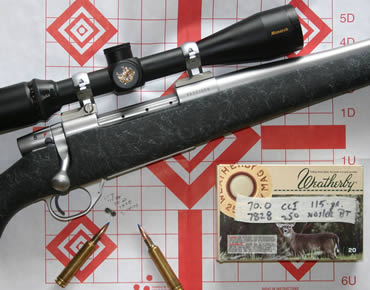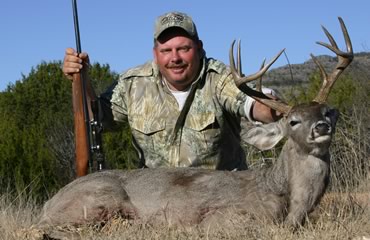Whitetail hunting isn’t always a short-range game.
Growing up a mule deer hunter out West, I was weaned on the importance of being able to make the first shot count at a deer three or four football fields away. We always tried to get closer, but sometimes it just wasn’t in the cards.
Most shots at whitetails are less than 200 yards, but there are exceptions. If you’ve hunted around croplands in the Heartland that cover a square mile or more, you know what I mean. How about Southern bean fields, the wide-open spaces of the West, a Texas sendero, or the grain and prairie country of southwestern Canada?
Then there are the diminutive Coues’ and Carmen Mountain whitetails of the Southwest, where bucks can be spotted a mile or more away before a stalk is even attempted.
We all hope for reasonably short shots, but it’s possible your one chance on a week-long hunt could stretch the limits of your skill. Unless you are prepared, it will be tag soup for supper.
There are several things required to make a long shot. These include a rifle/load/scope combination accurate enough to place the bullet on target, the skills to shoot with precision, and the ancillary equipment to set up properly.
If you watch TV hunting shows, you’ve seen guys make shots at game 600 to 1,000 yards away. I would never even consider taking those shots. I’m just not good enough. Rifle shots are made, not born. To shoot like those guys, you not only have to burn an inordinate amount of powder, you also have to have specialized equipment designed for the task.
Most of us can’t afford that kind of gear, nor are we able to practice like they do. Still, to become the best shot you can be, you need to shoot as much as you can on the practice range.
By practice range, I do not mean shooting from a bench. The bench is for sighting in a rifle and testing the accuracy of different loads. While hunting, there are four basic shooting positions: standing, kneeling, sitting and prone. For most whitetail hunting, I add an all-important fifth position: sitting in a chair while resting the rifle over the front bar of a treestand or out the window of a blind.
When not in a stand, I try to shoot only from either the sitting or prone positions.
Prone is by far the most stable and accurate shooting position, especially if you can use a bipod or rest the rifle’s fore-end on something soft like a hunting pack.
Sitting is my second choice. You often can’t lie down while on a hillside or in tall grass or brush. A solid set of shooting sticks — tripods are much steadier than bipod sticks — are worth their weight in gold. In both the prone and sitting positions, it is critical to steady the back elbow. The same is true when sitting in a treestand, shooting house or ground blind.
The best practice you can get is to shoot away from the bench under realistic conditions. I use a very large cardboard target holder and targets with an easy-to-see 8-inch bullseye. NRA slow-fire pistol targets are perfect for this. Once I get in the groove, I switch to a life-size paper deer target.
I begin from either a standing or sitting position, acquire the target with my optics, assume the proper shooting position and then take the shot. All this must occur in under a minute. You need to hurry but not rush. As a friend says, a slow hit is better than a fast miss.
Aside from all the little things you learn about how to get comfortable and steady the rifle, you’ll also learn just how far away you can hit the bullseye on a consistent basis. This will be a function of your skill and your rifle/load combination. Everyone has a different level of proficiency, so learn yours. Never shoot at game at distances you can’t make the shot nine times out of 10.
You’ll also find that shooting from the sitting position is more difficult than prone. In country where sitting shots are likely to occur, I often steady my right elbow and the rifle’s butt by placing a rolled-up jacket or a pack on my lap, especially if I can’t get my knees firmly up under my elbow.
The goal is to create bench-like steadiness, but it takes practice so it becomes automatic in the field. You also must learn to control your breathing.
 To make a long shot, you need a rifle/scope/load combination that is accurate enough to get the job done. I’ve read in some gun magazines that rifles that group three shots at 100 yards in something more than 1½ inches are not good enough for shooting at game more than a couple hundred yards away. I beg to differ. True, I want the most accurate rifle I can have, and I work very hard to make sure my pet rifles all group three shots in an inch cluster or less at 100 yards. That said, consistency is more important.
To make a long shot, you need a rifle/scope/load combination that is accurate enough to get the job done. I’ve read in some gun magazines that rifles that group three shots at 100 yards in something more than 1½ inches are not good enough for shooting at game more than a couple hundred yards away. I beg to differ. True, I want the most accurate rifle I can have, and I work very hard to make sure my pet rifles all group three shots in an inch cluster or less at 100 yards. That said, consistency is more important.
An example is my favorite rifle of all time, a .300 Win Mag topped with a Nikon Monarch 2.5-10x scope. That gun will put the first two shots virtually touching, and the third under an inch away, all day long. I know where the first two shots print, and if I can’t hit the target with the first two, shame on me. That said, a rifle/load combination that won’t hold a sub 2-inch group at 100 yards is not the kind of rifle you want to use for 400-yard shots.
We often make too much about which caliber is best. Flat-shooting rounds are better because the velocity helps minimize mistakes in range estimation, but never trade velocity for accuracy.
My current long-range whitetail rifle is a Weatherby Vanguard SUB-MOA in .257 Weatherby Magnum topped by a Nikon Monarch 4-14x scope set in Millet mounts. It sends a 115-grain Nosler Ballistic Tip bullet out at a screaming 3,400 fps and consistently groups three shots inside ¾ inch at 100 yards.
As for riflescopes for deer hunting, I have tried most, from fixed 4x scopes to variables with a top end power of 16x. There’s a reason that variables in the 2.5-10x are the biggest seller. For most big game hunting, 10x offers the best combination of magnification and steadiness. Unless you are skilled, it is really hard to keep the crosshairs steady at higher magnification, which means precise bullet placement is all but impossible.
The new generation of multi-crosshair scopes shows great promise for long-range shooting. These scopes use graduated horizontal crosshairs, or marks on the vertical crosshair, designed to match specific caliber/bullet weights at distances from 100 to 500 yards.
 I’ve played with several and currently have a Nikon Monarch 2.5-10x with a BDC reticle on one of my favorite .300s. The one caveat with any of these scopes is you need to shoot at long range so you know exactly where the bullet hits in relation to each circle, dot or crosshair. The software is a good starting point, but you must check your results against the pre-calculated numbers.
I’ve played with several and currently have a Nikon Monarch 2.5-10x with a BDC reticle on one of my favorite .300s. The one caveat with any of these scopes is you need to shoot at long range so you know exactly where the bullet hits in relation to each circle, dot or crosshair. The software is a good starting point, but you must check your results against the pre-calculated numbers.
With a plain vanilla crosshair-type scope, sight in your rifle to hit about 3 inches high at 100 yards. Using most modern deer hunting cartridges you should be able to hold dead on a buck’s chest from point blank range to 300 yards and kill it.
If your cartridge produces a muzzle velocity between 2,950 and 3,250 fps, the bullet will probably strike 2 to 4 inches low at 300 yards. If the bullet leaves the muzzle at 2,600 to 2,900 fps, it will probably strike the target 6 to 8 inches below the center of an 8-inch bullseye. At that range, you would hold on the top third of the target.
At 350 yards with the faster cartridges, put the crosshair just under the back-line. At 400 yards, hold about halfway up his head (but still over the vitals).
With the slower rounds at 350 yards, hold a smidge over the back line. At 400 yards, hold where the ears meet the skull. Of course, you need to practice shooting at these distances to see exactly what your rifle will do, but these guidelines will get you very close.
When I spot a deer at long range, the first thing that goes through my mind is, “There must be a way to get closer!” Only when all else fails will I set up for a long-range shot, and I take it only it if the planets line up and everything is perfect.
Read Recent Articles:
• High Mercury Whitetails: Sweat, bugs and extra effort aside, you can take big bucks when the weather is hot.
• Calling All Bucks: What you say and when you say it are crucial to successful calling.
• Shoot the Gap: How often does a buck show up at exactly 20, 30 or 40 yards?
This article was published in the Winter 2011 edition of Buckmasters Whitetail Magazine. Subscribe today to have Buckmasters delivered to your home.